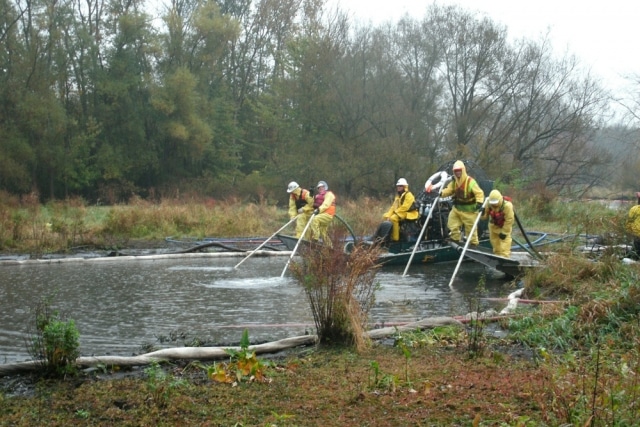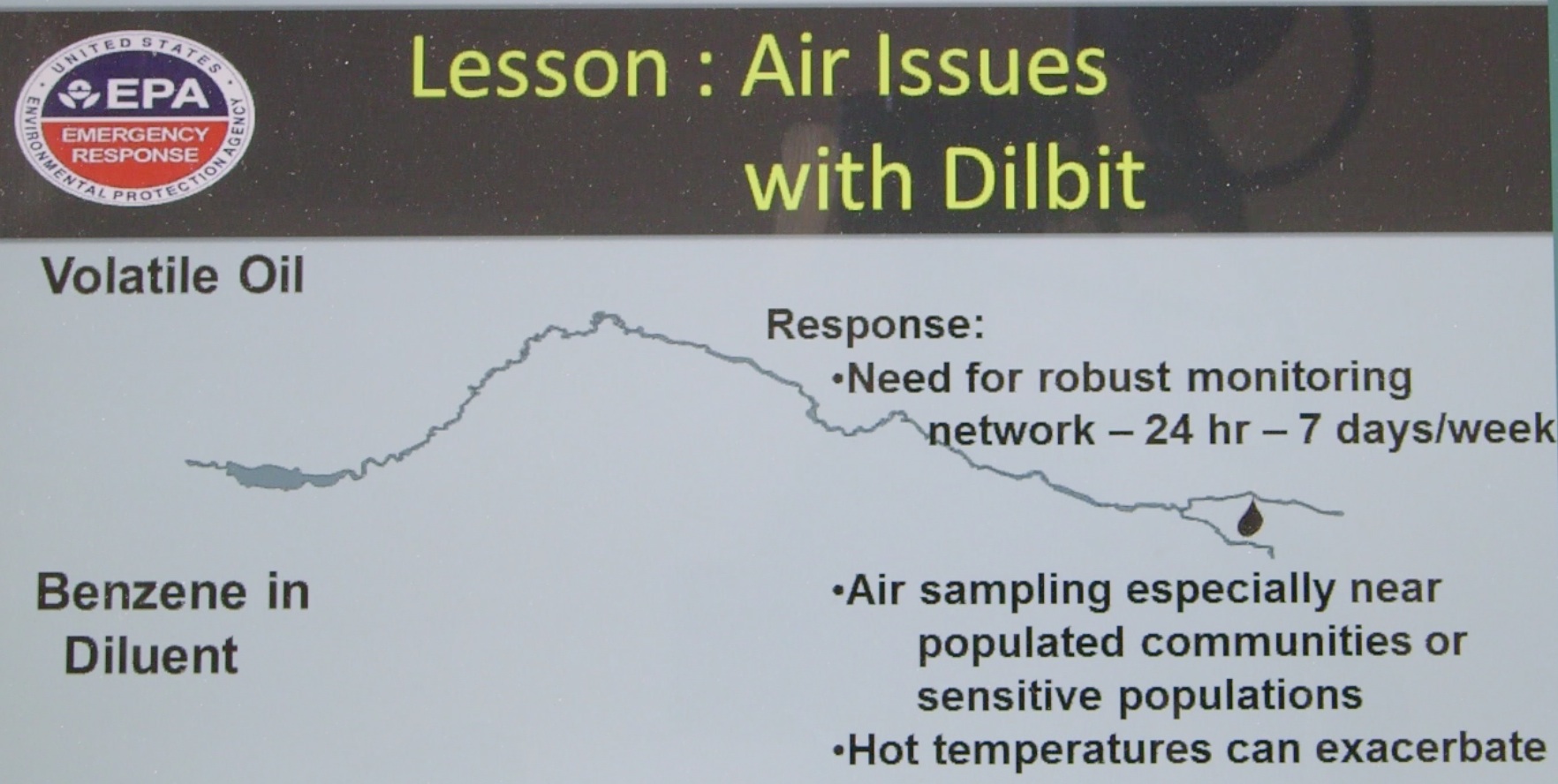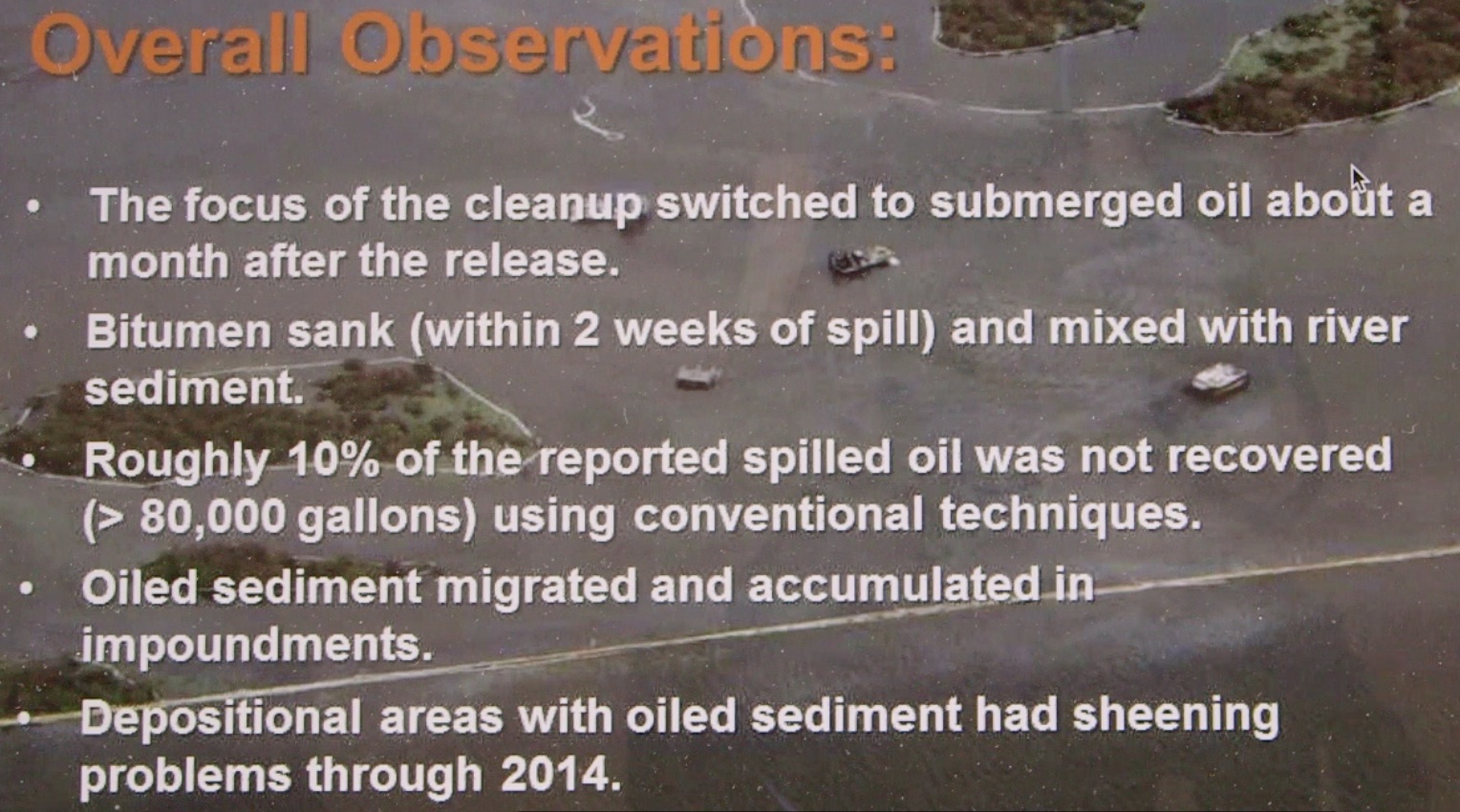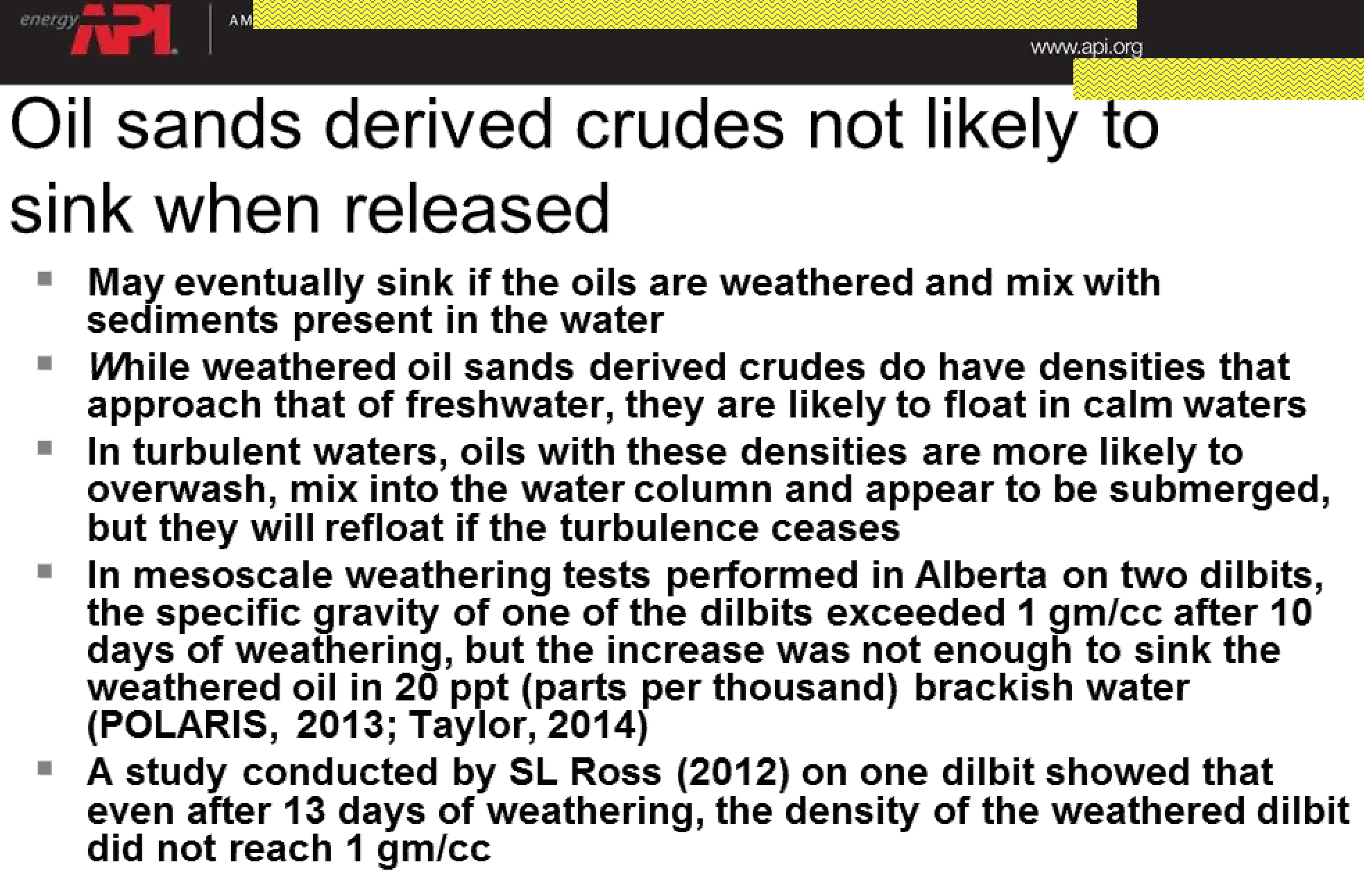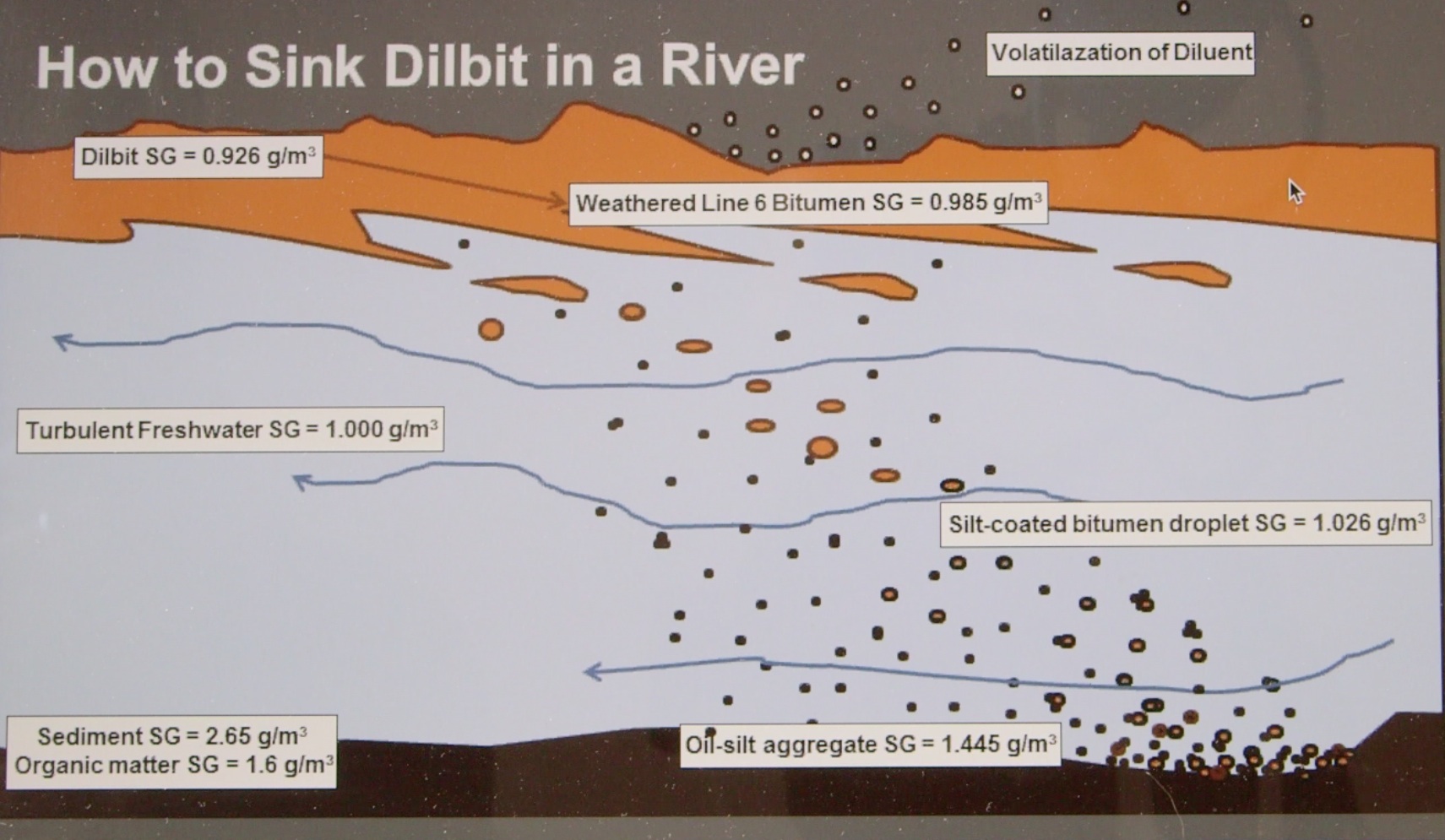“Once the oil started to sink, it made things a lot more difficult on our recovery.”
Those were the words of Greg Powell of the U.S. Environmental Protection Agency during his presentation on March 10th at the National Academy of Sciences conference on the Effects of Diluted Bitumen on the Environment. Powell was one of the people involved in the response and clean up of the Kalamazoo River tar sands dilbit spill in 2010 where an Enbridge pipeline cracked and spilled approximately one million gallons of diluted bitumen into the Kalamazoo River in Michigan.
Powell presented a disturbing account of what happened at Kalamazoo with pictures showing a river with “bank to bank” oil and contamination for almost 40 miles. This damage took over four years and more than a billion dollars to clean up. And Powell explained the main reason was that diluted bitumen isn’t like other oil.
Dilbit is a mixture of two distinct materials. One is the heavy tar-like bitumen that is the result of tar sands mining. The other is the highly flammable natural gas condensate that is mixed into the bitumen to lower the mixture’s viscosity and allow the diluted bitumen to be pumped through a pipeline or transported in a rail tanker car.
Throughout the two-day meeting, multiple presenters explained that the natural gas condensate/diluent starts evaporating as soon as there is a dilbit spill. This produces serious air quality issues due to the high levels of benzene involved. EPA‘s Powell had a slide on that:
Additionally, as has been shown with two recent dilbit-by-rail accidents, the natural gas condensate can also easily catch fire and cause explosions.
Once the diluent has fully volatilized or burned off, what is left is bitumen, which is what took years to clean up in Kalamazoo after it sank in the river.
And in Kalamazoo it wasn’t just that the bitumen sank, but the way it adhered to plants and surfaces and didn’t come off.
“We had to remove all of the vegetation along the stream bank because that oil would not come off,” Powell explained. He later said that they would, “Pressure wash rocks with it directly on the rocks and we couldn’t break that oil loose once it adhered to the rock.” At one point he stated, “it was like roofing tar.”
In one of Powell’s summary slides he made several observations about the spill noting that the focus of the cleanup “switched to submerged oil about a month after the release” and that the bitumen sank “within 2 weeks of the spill.”
What made Powell’s description of the behavior of the oil in the Kalamazoo spill particularly noteworthy was that it contradicted claims made in a presentation by the American Petroleum Institute (API) during Day 1 of the meeting. Peter Lidiak of the API said results from a new API-funded study about dilbit will be released in the near future but based on the preliminary findings, dilbit floats and doesn’t sink.
An interesting part of that study is that it lasted for 13 days. Dilbit doesn’t sink right away. Since it is a mixture of bitumen and volatile diluents like natural gas condensate, it doesn’t sink until the lighter natural gas condensate evaporates, leaving the heavier bitumen behind.
A 2013 study funded by Endbridge — the company that owned the pipeline that spilled dilbit into the Kalamazoo River — also concluded that dilbit didn’t sink. That study also only lasted 13 days. Powell had noted that the bitumen sank, “within two weeks of the spill.”
In much the same manner the API has claimed Bakken Shale oil isn’t different from other oils, citing studies funded by the oil industry, the industry is taking the same approach now with dilbit. Which make senses because the efforts with the Bakken oil have been very successful.
As reported recently by Reuters, the directive to have nothing in the new oil-by-rail regulations to require oil companies to remove the explosive natural gas liquids from Bakken oil prior to shipment, came from the White House. Meanwhile, two more Bakken oil trains have recently crashed and exploded.
Regardless of the industry-funded studies claiming dilbit is not going to sink, it is unlikely anyone who has seen the Kalamazoo River accident will believe them. Greg Powell’s presentation even contained a slide titled, “How To Sink Dilbit In A River” explaining how the bitumen ended up under water.
The sole public commenter at the NAS meeting was Jane Kleeb of Bold Nebraska, a grassroots group fighting eminent domain and the TransCanada Keystone XL pipeline and working to hold the corporations accountable for spill response and safety.
Kleeb explained to DeSmogBlog that Bold Nebraska has asked that all pipeline companies be required to have proper Material Safety Data Sheets available to local first responders detailing what is moving through the pipelines. The group also asked for the companies to provide proper equipment for first responders in the event of a dilbit spill in rural Nebraska.
Bold Nebraska had little success with either request.
“TransCanada has constantly pushed back on us saying we are alarmist and extremists and that it is not necessary,” Kleeb told DeSmogBlog.
During the conference it was noted that one of the problems with the Kalamazoo spill response was that initially Enbridge provided the wrong MSDS to the first responders.
Kleeb told DeSmogBlog she was pleased with one result from the meeting. “I was very relieved to know that the EPA and the Coast Guard both acknowledge the fact that yes, dilbit or tars sands or oil sands or however you are going to call it, does sink and that it is a problem.”
However, she maintains a healthy skepticism and expressed concern about the current study due to an earlier NAS study about the effects of dilbit on pipelines that was so popular with the industry it is touted on the Enbridge website.
“I fear the NAS study could just be a repeat of the first one,” said Kleeb.
While recent rail accidents with dilbit have resulted in reported spills of one million liters of dilbit as well as ruptured tanker cars ending up in a river, the conversation about dilbit in the environment at the meeting was dominated by the Kalamazoo event.
At one point, the EPA’s Powell was describing the spill response as it played out, and he recounted how someone called him to explain what seemed like good news.
“Get up here at 12 miles down the river, the oil disappears.”
We now know that it didn’t disappear and Powell explained what really happened. “Well it didn’t disappear, it just took on a new form once the condensate volatilized off,” he said.
The natural gas condensate volatilized off and the bitumen sank — which it does in the real world — but apparently does not in American Petroleum Institute and Enbridge-funded studies.
At the end of the two-day meeting, Commander Joseph Loring was asked what he would want to know first and foremost as a first responder to a dilbit spill. In his response, Loring referred to a dilbit spill as a “ticking time bomb” and summed up the one most important piece of information he would want to have.
“How long is it going to float?” Loring said. “That is the ultimate, I want to know how long I have.”
Image credit: U.S. EPA
Subscribe to our newsletter
Stay up to date with DeSmog news and alerts


